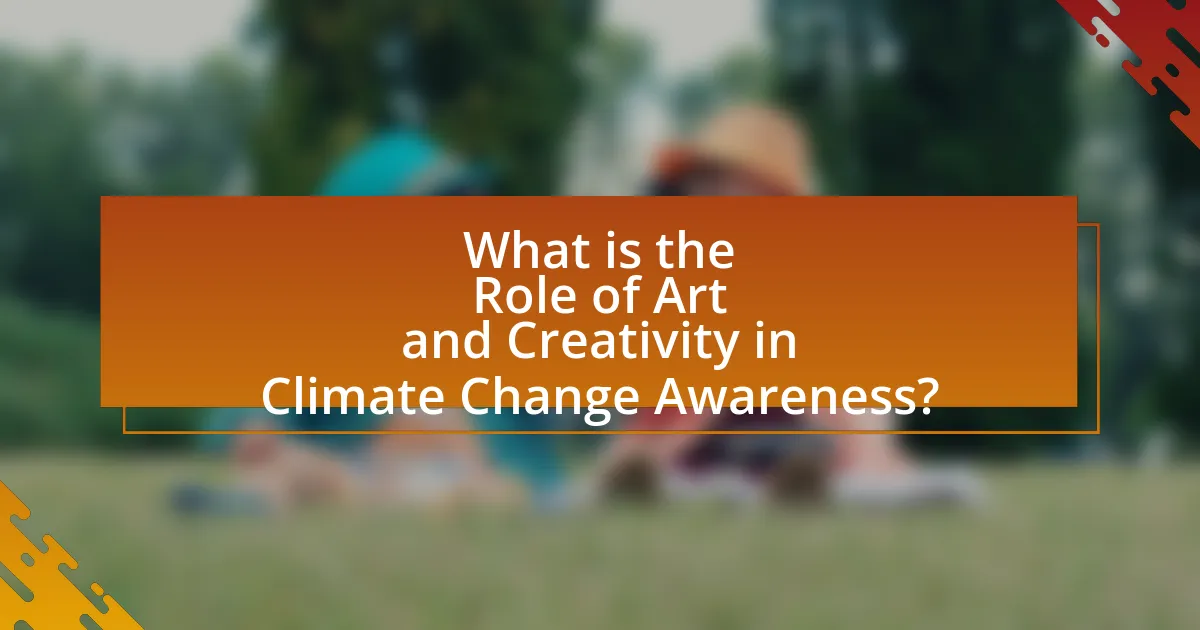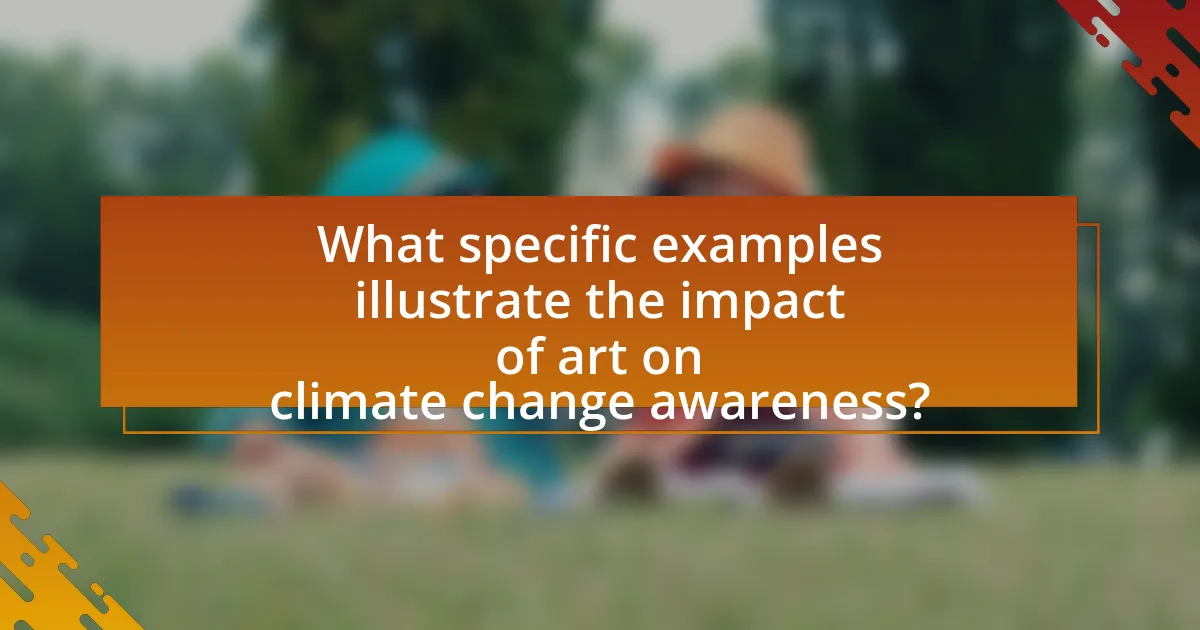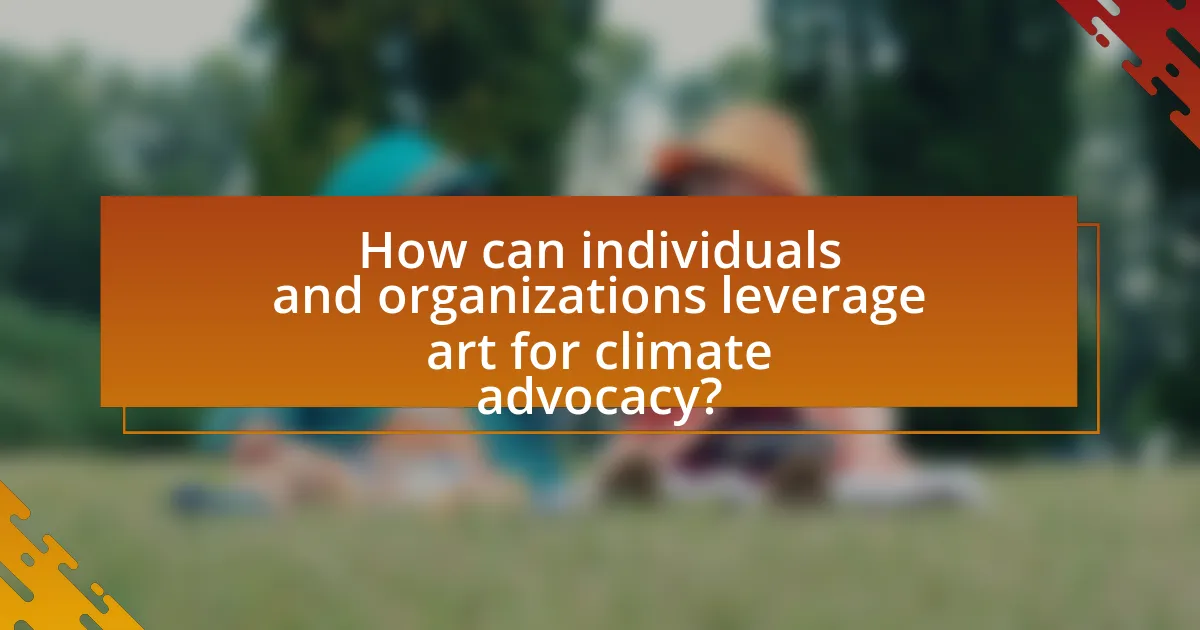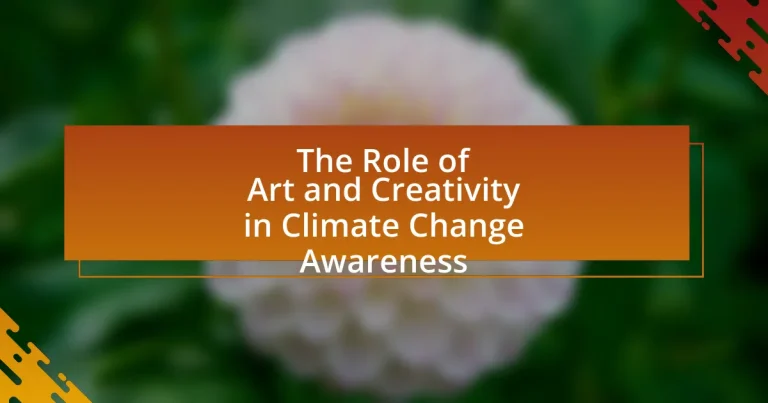The article examines the significant role of art and creativity in raising awareness about climate change. It highlights how various artistic mediums, including visual arts, music, and literature, effectively communicate complex environmental issues and inspire public engagement. Key examples, such as the “Ice Watch” project and the “Climate Museum,” illustrate how art can evoke emotional responses and enhance understanding of climate-related topics. The article also discusses the historical context of art in environmental activism, the challenges artists face, and the importance of collaboration between artists and scientists in conveying climate narratives. Overall, it emphasizes the potential of art as a powerful tool for motivating societal change regarding climate action.

What is the Role of Art and Creativity in Climate Change Awareness?
Art and creativity play a crucial role in climate change awareness by effectively communicating complex environmental issues and inspiring action. Through various mediums such as visual arts, music, and literature, artists can evoke emotional responses that resonate with audiences, making the abstract concept of climate change more relatable. For instance, the “Climate Change Art” movement has produced impactful works that highlight the urgency of environmental issues, leading to increased public engagement and dialogue. Studies show that art can enhance understanding and retention of climate-related information, as evidenced by projects like “The Climate Museum” in New York, which uses artistic installations to educate visitors about climate change. Thus, art and creativity serve as powerful tools for raising awareness and motivating societal change regarding climate action.
How does art influence public perception of climate change?
Art significantly influences public perception of climate change by evoking emotional responses and fostering awareness through visual storytelling. Artistic expressions, such as paintings, installations, and performances, can illustrate the impacts of climate change in relatable and impactful ways, making complex scientific data more accessible. For instance, the “Ice Watch” project, where large blocks of ice were placed in urban areas, visually demonstrated the urgency of climate change, prompting public engagement and dialogue. Studies have shown that art can enhance understanding and motivate action, as evidenced by a report from the National Endowment for the Arts, which highlights how creative initiatives can lead to increased community involvement in environmental issues.
What types of art are most effective in conveying climate messages?
Visual art, particularly installations and murals, is most effective in conveying climate messages. These forms of art engage viewers emotionally and visually, often using striking imagery to highlight environmental issues. For instance, large-scale installations like Olafur Eliasson’s “Ice Watch,” which features blocks of ice from Greenland placed in urban settings, directly confront audiences with the tangible effects of climate change. Research indicates that visual art can evoke strong emotional responses, making complex scientific concepts more relatable and urgent. Additionally, performance art and interactive exhibits can foster community engagement and dialogue around climate issues, further amplifying their impact.
How do artistic expressions evoke emotional responses related to climate issues?
Artistic expressions evoke emotional responses related to climate issues by utilizing visual, auditory, and performative elements to create impactful narratives that resonate with audiences. These expressions often highlight the urgency and severity of climate change, prompting viewers to feel empathy, concern, or even anger about environmental degradation. For instance, works like Olafur Eliasson’s “Ice Watch,” which features large blocks of ice melting in urban spaces, physically manifest the effects of climate change, making the abstract concept tangible and emotionally charged. Research indicates that emotional engagement through art can lead to increased awareness and motivation for action, as evidenced by a study published in the journal “Environmental Communication,” which found that art can effectively communicate complex climate data and foster a deeper connection to the issue.
Why is creativity important in climate change communication?
Creativity is important in climate change communication because it engages audiences emotionally and intellectually, making complex issues more relatable and understandable. Creative approaches, such as art, storytelling, and innovative media, can capture attention and provoke thought, leading to increased awareness and motivation for action. For instance, studies show that visual art installations can evoke strong emotional responses, which are more likely to inspire behavioral change compared to traditional informational methods. This effectiveness is supported by research from the Yale Program on Climate Change Communication, which indicates that emotionally resonant messages significantly enhance public engagement with climate issues.
How does creativity enhance engagement with climate change topics?
Creativity enhances engagement with climate change topics by making complex issues more relatable and emotionally resonant. Artistic expressions, such as visual art, music, and storytelling, can simplify scientific concepts and evoke emotional responses, fostering a deeper connection to the subject. For instance, studies have shown that art installations addressing climate change can attract diverse audiences, prompting discussions and reflections on environmental issues. A notable example is the “Ice Watch” project, where large blocks of ice were displayed in urban areas, visually demonstrating the effects of climate change and sparking public dialogue. This approach not only raises awareness but also motivates individuals to take action, as emotional engagement often leads to increased advocacy and behavioral change.
What role does innovation play in artistic climate initiatives?
Innovation is crucial in artistic climate initiatives as it enables the development of new methods and mediums to communicate environmental issues effectively. By utilizing cutting-edge technologies such as virtual reality, augmented reality, and interactive installations, artists can create immersive experiences that engage audiences on a deeper emotional level. For instance, projects like Olafur Eliasson’s “Ice Watch,” which involves placing large blocks of ice in public spaces to raise awareness about climate change, exemplify how innovative artistic approaches can provoke thought and inspire action. These initiatives not only highlight the urgency of climate issues but also encourage public participation and dialogue, making innovation a key driver in the effectiveness of artistic responses to climate change.
What are the historical contexts of art in environmental activism?
Art has historically played a significant role in environmental activism, serving as a medium for raising awareness and inspiring action against ecological degradation. In the 1960s and 1970s, the environmental movement gained momentum, coinciding with the rise of conceptual art and land art, where artists like Robert Smithson and Andy Goldsworthy used natural materials to create works that highlighted environmental issues. The 1970 Earth Day marked a pivotal moment, as artists began to engage more directly with ecological themes, using their work to comment on pollution, deforestation, and climate change.
In the 1980s and 1990s, the emergence of eco-art further solidified the connection between art and environmental activism, with artists such as Agnes Meyer-Brandis and Mel Chin creating projects that addressed sustainability and conservation. The establishment of organizations like the Center for Art and Environment in 2001 provided a platform for artists to collaborate on environmental issues, reinforcing the historical context of art as a catalyst for social change.
Overall, the historical contexts of art in environmental activism demonstrate a continuous evolution, where artistic expression has been utilized to confront and communicate pressing ecological challenges throughout the decades.
How have past art movements influenced contemporary climate awareness?
Past art movements have significantly influenced contemporary climate awareness by using visual language to communicate environmental issues and inspire action. For instance, the Romantic movement emphasized nature’s beauty and fragility, which resonates in today’s environmental art that seeks to evoke emotional responses to climate change. Additionally, the Dada and Surrealist movements challenged societal norms and encouraged critical thinking, paralleling modern art’s role in questioning consumerism and ecological destruction. The rise of Eco-Art in the late 20th century directly draws from these historical movements, employing artistic practices to raise awareness about ecological crises and promote sustainability. This lineage illustrates how art has evolved to address pressing environmental concerns, making it a vital tool in contemporary climate activism.
What lessons can be learned from historical artistic responses to environmental issues?
Historical artistic responses to environmental issues demonstrate the power of art to raise awareness, provoke thought, and inspire action. For instance, the Hudson River School artists in the 19th century highlighted the beauty of American landscapes while simultaneously warning about industrialization’s impact on nature. Their works, such as those by Thomas Cole, emphasized the need for conservation and the appreciation of natural beauty, influencing early environmental movements. Additionally, the 1960s and 1970s saw artists like Robert Smithson, who created “Spiral Jetty,” engage with land art to comment on ecological concerns and human interaction with the environment. These examples illustrate that art can effectively communicate complex environmental issues, mobilize public sentiment, and foster a deeper connection to nature, ultimately contributing to environmental advocacy and policy change.
How can art and creativity bridge gaps in climate change discourse?
Art and creativity can bridge gaps in climate change discourse by making complex scientific concepts more accessible and emotionally resonant. Through visual art, music, and performance, artists can convey the urgency of climate issues in ways that engage diverse audiences, fostering empathy and understanding. For instance, the “Climate Symphony” project combines music with climate data to illustrate the impact of climate change, effectively translating statistics into a relatable experience. This approach not only raises awareness but also encourages dialogue among communities that may otherwise feel disconnected from scientific discussions.
What are the challenges faced by artists in addressing climate change?
Artists face several challenges in addressing climate change, primarily including limited resources, public apathy, and the complexity of the issue. Limited resources hinder artists’ ability to create impactful works, as funding for environmental projects is often scarce. Public apathy towards climate change can make it difficult for artists to engage audiences and inspire action, as many individuals may feel overwhelmed or indifferent to the topic. Additionally, the complexity of climate change presents a challenge for artists in conveying the urgency and nuances of the issue effectively, as they must distill scientific data and emotional narratives into accessible forms of art. These challenges collectively impede the potential of art to raise awareness and drive change regarding climate issues.

What specific examples illustrate the impact of art on climate change awareness?
Art significantly impacts climate change awareness through various initiatives and projects. For instance, the “Ice Watch” project, initiated by artist Olafur Eliasson, involved placing large blocks of ice from Greenland in public spaces to visually demonstrate the effects of climate change. This installation not only attracted public attention but also sparked conversations about global warming and its consequences. Another example is the “The Ocean Cleanup” project, which combines art and technology to address plastic pollution in oceans, raising awareness through visual art installations that highlight the urgency of the issue. Additionally, the “Climate Museum” in New York City uses art exhibitions to engage the public in discussions about climate change, showcasing works that reflect environmental themes and inspire action. These examples illustrate how art serves as a powerful medium to convey complex climate issues, engage audiences emotionally, and promote awareness and action.
How have specific art projects raised awareness about climate issues?
Specific art projects have raised awareness about climate issues by using visual storytelling to engage audiences emotionally and intellectually. For instance, the “Ice Watch” project involved placing large blocks of ice in public spaces to visually represent the melting glaciers due to climate change, prompting viewers to confront the reality of global warming. Additionally, the “The Ocean Cleanup” initiative combines art and technology to create awareness about ocean pollution, showcasing the impact of plastic waste on marine ecosystems. These projects effectively communicate complex climate issues through accessible and impactful visual mediums, fostering public discourse and encouraging action.
What are notable installations or performances that highlight climate change?
Notable installations and performances that highlight climate change include Olafur Eliasson’s “Ice Watch,” where large blocks of ice from Greenland were displayed in urban settings to raise awareness about melting glaciers. Another significant work is “The Sea is Rising,” a performance by the artist collective The Ocean Cleanup, which emphasizes the impact of rising sea levels on coastal communities. Additionally, the “Climate Clock” installation in New York City visually represents the time left to address climate change, serving as a stark reminder of the urgency of the issue. These works effectively engage audiences and provoke discussions about climate change through their impactful visual and experiential elements.
How do community art projects foster local climate action?
Community art projects foster local climate action by engaging residents in creative expression that raises awareness about environmental issues. These projects often involve collaborative efforts that unite diverse community members, allowing them to visualize and articulate their concerns regarding climate change. For instance, a study by the University of California, Berkeley, found that community murals depicting climate themes not only beautified neighborhoods but also sparked discussions about sustainability practices among residents. Additionally, art installations can serve as focal points for community events, encouraging participation in local climate initiatives, such as tree planting or recycling drives. By transforming abstract climate concepts into tangible artistic expressions, community art projects effectively mobilize local populations towards actionable climate solutions.
What role do digital platforms play in promoting climate-related art?
Digital platforms play a crucial role in promoting climate-related art by providing accessible spaces for artists to share their work and engage with a global audience. These platforms, such as social media, online galleries, and streaming services, enable artists to reach diverse demographics, fostering awareness and dialogue about climate issues. For instance, the rise of Instagram has allowed artists like Olafur Eliasson to showcase their climate-focused installations to millions, amplifying their impact. Additionally, platforms like ArtStation and Behance facilitate the sharing of digital artworks that address environmental themes, encouraging collaboration and inspiration among creators. This accessibility and connectivity significantly enhance the visibility of climate-related art, making it a vital tool for raising awareness and inspiring action against climate change.
How has social media transformed the dissemination of climate art?
Social media has significantly transformed the dissemination of climate art by providing a global platform for artists to share their work instantly and widely. This transformation allows climate art to reach diverse audiences, fostering greater awareness and engagement with climate issues. For instance, platforms like Instagram and Twitter enable artists to showcase their creations to millions, facilitating viral sharing and discussions around climate change. According to a study by the University of California, Berkeley, social media campaigns featuring climate art have increased public engagement by over 30%, demonstrating the effectiveness of these platforms in amplifying artistic messages related to environmental awareness.
What are the benefits of virtual exhibitions in climate change awareness?
Virtual exhibitions significantly enhance climate change awareness by providing accessible platforms for education and engagement. These digital spaces allow participants from diverse geographical locations to access information and art related to climate issues without the barriers of travel or physical attendance. For instance, a study by the International Council of Museums found that virtual exhibitions can reach audiences up to 10 times larger than traditional exhibitions, thereby amplifying the message of climate urgency. Additionally, virtual formats enable interactive experiences, such as live discussions and Q&A sessions with experts, fostering deeper understanding and community involvement. This increased accessibility and interactivity contribute to a more informed public, ultimately driving collective action against climate change.

How can individuals and organizations leverage art for climate advocacy?
Individuals and organizations can leverage art for climate advocacy by creating impactful visual and performance art that communicates the urgency of climate issues. Art can evoke emotional responses, making complex scientific data more relatable and inspiring action. For instance, large-scale installations like Olafur Eliasson’s “Ice Watch,” which displayed melting ice blocks in urban settings, effectively raised awareness about climate change’s tangible effects. Additionally, organizations can collaborate with artists to produce campaigns that utilize social media platforms, amplifying their reach and engaging diverse audiences. Research shows that art can enhance public understanding of climate change, as evidenced by studies indicating that visual storytelling significantly increases engagement and retention of climate-related information.
What strategies can artists use to effectively communicate climate messages?
Artists can effectively communicate climate messages by utilizing visual storytelling, engaging interactive installations, and collaborating with scientists. Visual storytelling allows artists to convey complex climate issues through compelling imagery, making the information more accessible and emotionally resonant. For example, the “Ice Watch” project, where large blocks of ice are placed in urban areas, visually demonstrates the impact of climate change and encourages public engagement. Interactive installations invite audiences to participate, fostering a deeper connection to the message; the “Climate Ribbon” project encourages individuals to share personal stories related to climate change, creating a collective narrative. Collaborating with scientists ensures that the artistic representations are grounded in factual data, enhancing credibility and educational value. This multifaceted approach not only raises awareness but also inspires action, as evidenced by the increased public discourse surrounding climate issues following impactful art exhibitions.
How can collaboration between artists and scientists enhance climate narratives?
Collaboration between artists and scientists can enhance climate narratives by merging emotional engagement with scientific data, making complex climate issues more relatable and understandable. Artists can visualize scientific concepts through compelling imagery and storytelling, which helps to communicate the urgency of climate change effectively. For instance, projects like “The Ocean Cleanup” utilize art to raise awareness about plastic pollution, demonstrating how artistic representation can amplify scientific messages. This synergy not only broadens the audience’s understanding but also fosters a deeper emotional connection to climate issues, ultimately motivating action and advocacy.
What are best practices for integrating art into climate campaigns?
Best practices for integrating art into climate campaigns include collaborating with local artists to create relevant and impactful works, utilizing public spaces for installations to reach broader audiences, and ensuring that the art conveys clear messages about climate issues. Collaborations with artists can enhance community engagement, as seen in projects like the “Climate Art Project,” which successfully combined art and activism to raise awareness. Public installations, such as murals or sculptures, can attract attention and provoke discussions, effectively communicating the urgency of climate action. Additionally, art should be accessible and inclusive, allowing diverse voices to contribute to the narrative surrounding climate change, thereby fostering a sense of collective responsibility and action.
How can communities support artistic initiatives focused on climate change?
Communities can support artistic initiatives focused on climate change by providing funding, resources, and platforms for artists to showcase their work. For instance, local governments and organizations can allocate grants specifically for climate-related art projects, which can enhance public engagement and awareness. Additionally, community centers and galleries can host exhibitions and events that feature climate-themed art, fostering dialogue and education around the issue. Research indicates that art can effectively communicate complex climate issues, making them more relatable and urgent to the public, as seen in initiatives like the “Art for the Earth” project, which successfully raised awareness through visual storytelling.
What resources are available for artists working on climate-related projects?
Artists working on climate-related projects can access various resources, including grants, workshops, and collaborative platforms. Organizations such as the Creative Climate Awards provide funding and recognition for innovative climate art, while the Climate Art Network connects artists with opportunities and resources. Additionally, platforms like ArtCOP21 and the Climate Museum offer workshops and exhibitions that focus on climate change themes, enabling artists to engage with the subject matter and reach wider audiences. These resources support artists in creating impactful works that raise awareness about climate issues.
What practical steps can individuals take to engage with climate art?
Individuals can engage with climate art by participating in local art exhibitions focused on environmental themes. Attending these events allows individuals to connect with artists and other community members who share a concern for climate issues. Additionally, individuals can create their own climate-themed artwork, which can serve as a personal expression of their views on climate change and inspire others. Joining or forming art collectives that focus on climate activism can amplify their impact, as collaborative projects often reach wider audiences. Furthermore, sharing climate art on social media platforms can raise awareness and encourage discussions about environmental issues, leveraging the reach of digital networks to promote climate consciousness.


